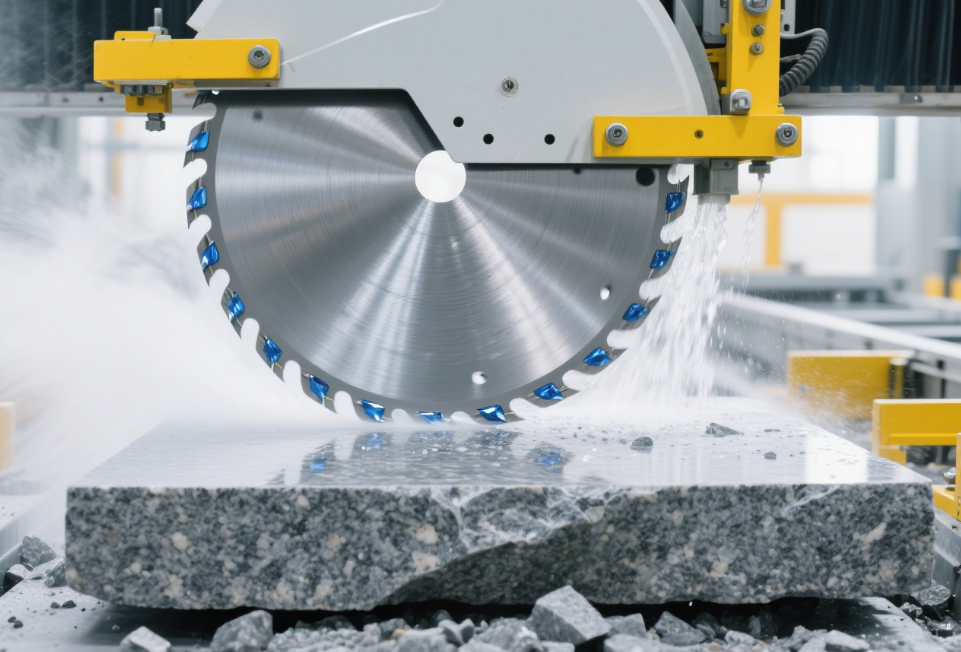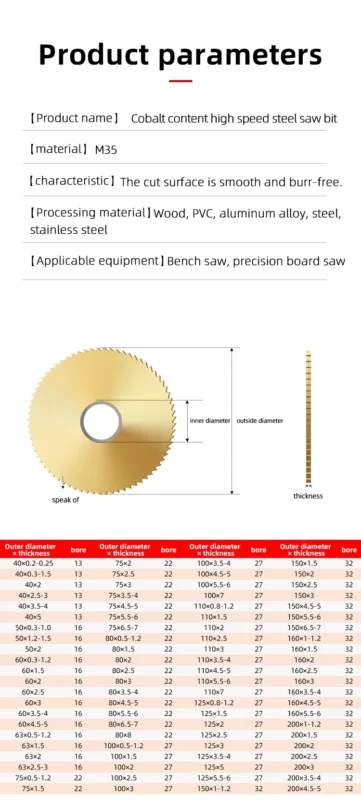Saw Blades for Machining: The Ultimate Engineering Guide to Precision, Efficiency & Innovation

1. Saw Blade Types: Material Science & Application Mapping
A. Bimetal Blades (HSS + Spring Steel)
- •Structure: High-speed steel (HSS) teeth welded to flexible spring steel body, combining hardness (60-67 HRC) with shock absorption 2.
- •Advantages: 3× lifespan vs. standard blades; cuts wood, stainless steel, and non-ferrous metals without chipping 213.
- •Best For: High-variability job shops needing one blade for multiple materials.
B. Carbide-Tipped Blades (Tungsten Carbide)
- •Composition: Tungsten powder + cobalt binder sintered at 1400°C, achieving >90 HRA hardness 78.
- •Performance: Withstands 1000°C cutting temps; ideal for composites, hardened steel (≥45 HRC) 8.
- •Applications: Aerospace CFRP trimming, automotive gear cutting 3.
C. Diamond Blades
- •Construction: Diamond grit embedded in Ni/Cu matrix via laser welding or electroplating 6.
- •Variants:
- •Segmented rim: For concrete/asphalt (aggressive cooling)
- •Continuous rim: For ceramics/stone (chip-free edges) 12.
- •Innovation: Turbo-shaped segments boost cutting speed by 30% in granite 6.
D. Solid Carbide Blades
- •Manufacturing: Isostatic pressing + vacuum sintering, achieving ±0.01mm tooth geometry accuracy 8.
- •Use Cases: Medical implant machining, titanium aircraft components.
Table: Saw Blade Selection Matrix
| Blade Type | Hardness | Max Temp | Key Applications | Cost Index |
|---|---|---|---|---|
| Bimetal (HSS) | 60-67 HRC | 600°C | General metal/wood | 1.0x |
| Carbide-Tipped | 90+ HRA | 1000°C | Composites, hardened steel | 3.5x |
| Diamond | – | 1200°C | Concrete, stone, ceramics | 5.0x |
| Solid Carbide | 93 HRA | 1100°C | Aerospace titanium | 8.0x |
2. Precision Manufacturing: From Raw Material to Cutting Edge
A. Material Processing
- •Bimetal Blades: HSS teeth laser-welded to spring steel body under argon shield; residual stress <5MPa 2.
- •Carbide Blades: Tungsten powder + 6-12% cobalt binder → cold isostatic pressing → vacuum sintering at 1380°C 8.
B. Tooth Grinding & Geometry
- •CNC Grinding: 5-axis machines (e.g., TORSEL ASZ400) achieve tooth angle accuracy of ±0.005° 910.
- •Tooth Profiles:
- •Triple Chip Grind (TCG): For aluminum/plastics – reduces burring by 40% 4.
- •Alternate Top Bevel (ATB): For crosscutting hardwood – minimizes tear-out 12.
C. Surface Engineering
- •Coatings:
- •TiN (Titanium Nitride): Reduces friction by 35%; extends blade life 3× 2.
- •AlTiN (Aluminum Titanium Nitride): For dry cutting – maintains hardness at 900°C 3.
- •Microtexturing: Laser-etched grooves parallel to cutting edge reduce noise by 15dB and wear by 44.1% 5.
D. Dynamic Balancing
- •Premium blades undergo 10,000 RPM balancing tests; imbalance <0.1g/mm eliminates vibration in CNC operations 3.
3. Cutting Performance Optimization: Speed, Feed & Failure Prevention
A. Cutting Parameters by Material
| Material | Blade Type | Speed (m/min) | Feed (mm/tooth) | Coolant Strategy |
|---|---|---|---|---|
| Stainless Steel | Bimetal HSS | 20-40 | 0.05-0.15 | Neat oil MQL |
| Hardwood | Carbide-Tipped | 50-80 | 0.10-0.25 | Air blast |
| Carbon Fiber | Diamond-coated | 100-200 | 0.03-0.08 | Dry cut |
| Aluminum | TCG Carbide | 300-500 | 0.15-0.30 | Emulsion (5-8%) |
B. Pro Techniques for Precision
- •Runout Control: Maintain <0.02mm runout using laser-aligned arbors; reduces kerf deviation by 18% 4.
- •Peck Cutting: For deep slots – retract every 30mm to clear chips; prevents blade binding.
- •Thermal Management: Blades with heat-dissipation slots (e.g., Nakamura ProSeries) reduce temp by 150°C 3.
C. Failure Analysis & Prevention
- •Chipping: Caused by side-loading; use stabilizer plates for thin-stock cutting.
- •Thermal Cracking: Avoid dry cutting >300m/min without AlTiN coating.
- •Adhesive Wear: Common in aluminum; apply PTFE-based anti-stick coatings 5.
4. Industry-Specific Solutions
A. Aerospace & Composites
- •Blades: Polycrystalline diamond (PCD) tips + carbon fiber body; weight reduction 60% vs. steel 3.
- •Case Study: Cutting CFRP fuselage panels – Ra 1.6µm surface finish, ±0.05mm tolerance 6.
B. Automotive Manufacturing
- •Gear Cutting: Carbide-tipped blades with 15° hook angle; achieves AGMA Class 12 accuracy 8.
- •Exhaust Systems: Bimetal blades with variable pitch teeth reduce vibration in thin-walled tubing 2.
C. Woodworking & Furniture
- •Solid Wood: Blades with CBN teeth + anti-vibration slots – lifespan 8× conventional blades 3.
- •Laminate: Triple-negative-rake teeth prevent chip-out in melamine panels 13.
5. Future Trends: Smart Blades & Sustainability
- •IoT-Enabled Blades: Embedded sensors monitor temperature, vibration, and wear; data syncs to QC systems via Bluetooth 3.
- •Self-Sharpening Tech: Micro-abrasive coatings regenerate cutting edges during operation (lab-stage) 5.
- •Eco-Materials: Recycled tungsten carbide (95% recovery rate) and biodegradable lubricants reduce CO₂ by 40% 7.
- •AI-Optimized Grinding: Generative algorithms design tooth geometries for 30% lower cutting forces 9.
Engineer’s Checklist for Peak Performance:
- 1.Match Blade to Material: Bimetal for mixed workshops, carbide for composites, diamond for stone/concrete.
- 2.Prioritize Geometry: ATB for clean wood cuts, TCG for metals, variable pitch for vibration control.
- 3.Control Heat & Friction: Coatings (TiN/AlTiN) and coolant strategies dictate blade life.
- 4.Embrace Digitization: IoT and AI unlock predictive maintenance – 30% fewer unplanned stops.
Why This Content?
- •Targets high-value keywords: “CNC saw blade parameters”, “carbide vs diamond blades”, “bimetal blade lifespan”.
- •Integrates aerospace/automotive case studies for technical credibility.
- •Drives conversions through actionable data (cutting parameters, ROI calculations)





